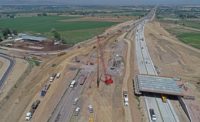ENR Intermountain's 2013 Owner of the Year: Utah Dept. of Transportation








On a wet, overcast day last December, Utah Gov. Gary Herbert stood on the deck of the new Sam White Bridge over Interstate 15 and announced the completion of the I-15 Corridor Expansion, or CORE. The $1.7-billion project expanded and improved 24 miles of I-15 through Utah County in a record 35 months. It was the fastest completion of a billion-dollar-plus highway project in the U.S.
But it was only the second major highway opening that day. Several hours earlier in western Salt Lake County, the Utah Dept. of Transportation also celebrated first-phase completion of the Mountain View Corridor (MVC). The $270-million phase included 15 miles of new two-lane roads, bridges, signalized intersections and trails.
Finishing two such monumental projects on the same day, both under budget and ahead of schedule, punctuated how busy UDOT transportation officials and highway builders in the Beehive State have been.
"Completing those projects last year was a major milestone and a real high point for our agency," says UDOT executive director John Njord, who recently announced his retirement from the agency he has led since 2001. A national search for Njord's replacement is currently under way.
Njord leaves the agency with a solid record of securing funding for and delivering transportation projects to the fifth-fastest-growing state in the nation, according to recent census data. In 2012, UDOT says it completed 200 projects, large and small, with an estimated total value of around $3 billion. At one point last year, UDOT projects were employing nearly 16,000 non-government workers.
According to Njord, that activity results from the agency's focus on four key goals: preserving infrastructure, optimizing mobility, ensuring zero fatalities and strengthening the economy. He says the goals were developed in 2003 after the agency's successful rebuilding of a large section of I-15 near Salt Lake City to prepare for hosting the 2002 Winter Olympic Games.
"We wanted a way of focusing our energy on the things we do that are the most important as an agency," Njord says. "It also goes to an individual level so our people can see how their jobs relate to our goals."
He says the fourth goal, strengthening the economy, escalated in importance in recent years as the local and national economies struggled. The agency took a hard look at how its activities affect employment and business success across the state and in local communities.
Njord and UDOT deputy director Carlos Braceras say that for several years, the agency has placed high value on the length of time a contractor expects to have a highway restricted or closed. "We understand the impact we have on the local economy and the life of an area. When we look at a bid, whether it is CM/GC or design-build, we bid it as price plus time," Braceras says. "We ask for two numbers and put a value on time and consider where the project is. We bring those numbers together and usually the (contractor) who can do that project faster gets it."
A stipulation for the CORE construction team Provo River Constructors (Flour, Ames Construction Co., Ralph L. Wadsworth Construction and Wadsworth Brothers Construction, all from Utah) was that it keep at least two traffic lanes in each direction open at all times. Similar conditions were in place during construction of new interchanges on I-15 and Dixie Drive (ENR Mountain States 8/29/11 p. MS63) in southern Utah around the city of St. George.
New Delivery Methods
During his 12 years leading UDOT, Njord has served in the Cabinet of three different governors. He is a registered professional engineer and a graduate of the University of Utah. Braceras has been his deputy director and chief engineer since 2001. The two have guided the department through major projects and built relationships with state lawmakers and contractors.






